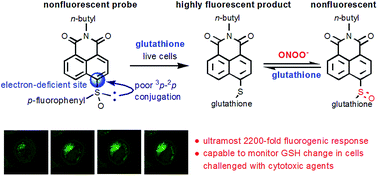An ultrasensitive fluorogenic probe for revealing the role of glutathione in chemotherapy resistance†
Abstract
Unveiling the detailed roles of glutathione (GSH) in chemoresistance necessitates a reliable assay for its detection in intact live specimens. Herein, by taking advantage of the susceptibility of electron-poor Csp2–Ssufinyl bond to GSH nucleophilic attack, we developed a naphthalimide–sulfoxide based fluorogenic probe (Na-8) applicable for tracking endogenous GSH fluctuation in live cells. Na-8 features a high degree of sensitivity towards GSH as demonstrated by its utmost 2200-fold fluorogenic response. As a proof of concept, Na-8 has been applied to image GSH in liver cancer HepG2 cells with the normal L02 cell counterparts serving as a control, and elevated GSH level was observed in HepG2 in contrast to L02. Further experiments showed that this elevated GSH level was involved in doxorubicin-resistance but not in cisplatin-resistance. Noteworthy, monitoring GSH change in HepG2 and L02 cells in response to doxorubicin treatment revealed that while normal cells showed a burst of GSH in adaption to doxorubicin treatment, no significant change was detected in HepG2 cells, suggesting that HepG2 cells have been preconditioned by their intrinsic oxidative stress which confers drug-resistance. Given the observed sensitivity and spatiotemporal resolution, Na-8 should hold promise for future study on the detailed roles of GSH in drug-resistance.



 Please wait while we load your content...
Please wait while we load your content...